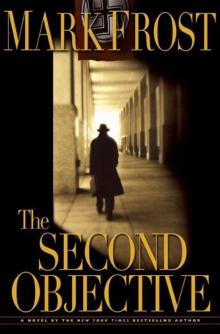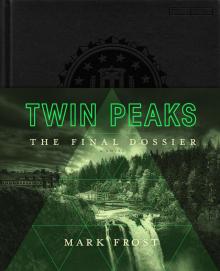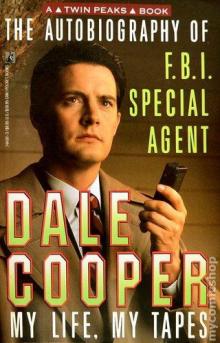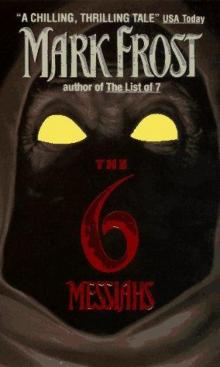- Home
- Mark Frost
Twin Peaks: The Final Dossier Page 10
Twin Peaks: The Final Dossier Read online
Page 10
Laura was never there.
After a while, with a complete lack of tips, leads, or sightings to move an investigation forward, the Laura Palmer story began to fade. Within a month it had gone cold; another “missing person” story with no clear resolution. As mentioned, I did find a few stories in the Post about Agent Cooper coming to town to investigate Laura’s disappearance—there are not many details to speak of, and he didn’t stay long—and nothing much beyond that. (As soon as I return to the office, I intend to look into whether any of Cooper’s files or tapes that are still in our possession support this alternate version of events.)
I kept moving forward, searching for more information about the Palmer family. The following year, on February 24, 1990—the one-year anniversary of her “disappearance”—Leland Palmer committed suicide. Alone, with a licensed handgun, in his car, parked near the waterfall by the big hotel. The usual outpouring of shock, grief, and “we never saw this coming” stories appeared in the local press. The act was generally attributed to “a father’s overwhelming grief about the unresolved disappearance of his only child.” Checking police records, I found that there were at least three visits paid to the Palmer house during that intervening year—all by Sheriff Harry Truman—but no further details about the reasons for them are available, and neither is Sheriff Truman.
I decided to look at the history of the mother; with her being Laura’s only living relative now, there was scarcely anywhere else to look.
Sarah Judith Novack Palmer.
I searched all the way back to her childhood in New Mexico, where the family moved—months after her birth in Bellevue, Washington—in the summer of 1943. Her father was a Defense Department employee who had been transferred there to work in some small but unspecified subcontractor role on the Manhattan Project. The family lived outside Los Alamos, in a new suburb built on the edge of the desert specifically for workers involved in the program. Nothing about their family life during that time particularly stands out, unless you count the first successful nuclear bomb test—code name “Trinity”—which took place at White Sands, New Mexico, on July 16, 1945. You know the rest of that story: Less than a month later, atomic bombs were dropped on Hiroshima and Nagasaki and the war with Japan was over.
The Novacks decided to stay on in the area—her father still working for the Defense Department—and as far as the public record is concerned, the rest of Sarah’s childhood passed uneventfully. But eleven years later, on August 6, 1956, there was a curious incident that I found reported in the local newspaper. That night, about fifteen miles outside of the town where the Novacks lived, an AM radio station was viciously and mysteriously attacked. Two employees—a receptionist and a nighttime DJ—were found dead inside the building, their heads crushed in particularly gruesome fashion by what forensics called “extreme blunt force trauma.”
Included in the accounts that followed over the next few days: half a dozen sightings of strange solitary figures in the area that night, on the road, with at least two placing them in the vicinity of the radio station. Details are sketchy—it was a dark, moonless night—but they sound like drifters or, as one witness called them, “hobos.”
Also reported that night: Shortly after the time they believe this attack took place, the station abruptly went off the air. At which point more than a few people reported hearing strange “electrical or mechanical word sounds” coming over their radios for about the next six minutes. During this period, many local residents reported severe disturbances among their pets or livestock. A number of others—although only a few are named in the reporting—claimed that members of their family blacked out when they heard these transmissions. When the sounds stopped, just as abruptly as they’d started, and the station went to dead air—which, when they were unable to raise anyone there on the phone, prompted police to head to the station—all of these people immediately regained consciousness, with no memory of the event.
Two of the people named in that account lived in the Novacks’ neighborhood. Sarah Novack was one of them: According to her parents, they found Sarah unconscious and unresponsive in her upstairs bedroom. She came around in the backseat as they were rushing her to the hospital. According to the newspaper report, emergency room doctors found nothing wrong with the girl—it was the same with all of those they looked at that night; the paper suggests it was close to a dozen people—and she was released after a cursory examination.
What to make of it? I have no idea, do you? This may not mean anything, either, but all of this took place a few hours away from the air base at Roswell, where, as we know from the dossier, a young army officer named Doug Milford allegedly witnessed the mysterious “UFO” crash nine years earlier.
Sarah’s life rolled on uneventfully. She attended college back in Washington State, where she met the man who would become her husband, and later gave birth to their only child, Laura. After Laura’s disappearance, Sarah experienced bouts of severe depression and was treated for it, as previously reported. In the years since—at least in the version where her husband commits suicide—according to medical records she has battled alcoholism, addiction to prescription drugs, and social isolation.
Oh, and in the past year, right around the time Cooper disappeared again and time took a vacation, she was named and questioned as an eyewitness to a particularly gruesome and mysterious death in a disreputable Twin Peaks dive, where a man on the barstool next to her dropped dead with most of his neck missing.
* * *
Chief, I’m glad I’ve written all this down rapidly, because my own thoughts about every one of these events are growing fuzzier and more indistinct the longer I stay here, creeping into my mind like a mist. I can feel a kind of mental lassitude physically advancing on me. Something’s wrong; whether it’s with me or this place, I don’t know and I don’t really care anymore. I need to pull the emergency brake, right now, and get the hell out of here. I’ve booked a flight back to Philadelphia tomorrow.
FINAL THOUGHTS
I’m on the plane now, in the air, forty minutes east of Spokane. The uncanny penumbra I reported hasn’t left me—I barely slept—but it’s fading as I travel farther east. I don’t know what to make of it.
You wanted to know what happened there in that town and region, to these people you knew, whom I feel I’ve come to know now as well. They meant something to you for a reason, I think, beyond just your knowing them, beyond that they were good or interesting people in their own right: because it was all there, in that one town. All of life, cradle to grave, every shade and color of the spectrum, like a fractal, itself made up of infinite parts. The ocean in a drop of water.
I feel like I laid my hand on a third rail that should be of concern to all of us: that a core fundamental of human existence is wonder—and its analogue is fear. You can’t have one without the other, flip sides of the coin.
And even as we “wonder” at what we’re doing here, so do we also fear—so deep down below the surface of our lives that few can bear to look at it—that life is a meaningless jest, an extravagant exercise in morbidity, a tale of sorrow and suffering lit by flashes, and made bearable only by moments of companionship and unsustainable joy. Along the way, as we struggle to come to terms and comprehend why this strange fate has befallen us, time becomes no longer our ally—the spendthrift assumption of our youth—but our executioner. It all feels at times like a merciless joke made at our expense, without our consent.
Is the evil in us real? Is it an intrinsic part of us, a force outside us, or nothing more than a reflection of the void? How do we hold both fear and wonder in the mind at once? Does staring into this darkness offer up an answer, or resolution? What does it give us to hold on to? Does it reveal anything at all?
Or can the simple, impossible act of persisting to look at what’s in front of us finally pierce the blackness and reward us with a glimpse of something eternal beyond? Is that “heaven”? How do we manage it? The only answer I can console myself with is this
: What if the truth lies just beyond the limits of our fear, and the only way to reach it is to never look away? What if that’s why we must keep going, why we can never quit trying to overcome it in every moment we’re alive?
Look at all that’s happened here. One town. The commonplace, familiar, and ordinary—everything we think we know, until you sense the deep, unsettling strangeness informing all of it. How easy it is to quit, give up, lower our eyes. Look at what happens to anyone here who lost the fight, many of whose stories we both now know so well. How recklessly, stupidly we toss away this one chance we have, simply squander it, money down the drain, a thousand different ways. We’re holding the coin of the realm in our hands the whole time and we can’t even see it.
What I’ve learned from this place and about these people terrifies me, I’ll frankly admit that. How much of what I know, what I’ve been culturally attuned to believe, feels like the set of a play on a strange stage I’ve wandered onto without knowing why I’m here. I don’t know the lines, I don’t know what part I’m playing, I don’t even know what the play’s about or what it’s called. I’m just here onstage, stuck in a dream, lights shining in my eyes. Is anyone out there watching? The play stumbles ahead, feels like artifice, mistakes, frippery, an endless series of false starts, bad assumptions, all the while shadowed with the constant horror that something unforeseen could drop down on me from above or lurch in from the wings at any moment, that the floor could open beneath me and instantly erase even this small, pitiful existence, put out the lights for good.
Chief, this has changed me. You predicted that, and I should have known you’d be right, but you can’t know what you don’t know until you do. It’s because you’ve already been through it, I think. Does this feeling end? Can you tell me you come out the other side to some kind of understanding, or do I have to take that as another article of faith? There’s only one redeeming feeling I can cling to, provided I ever get that far—and I’m not saying I’m there yet, by any stretch—but when it’s all stripped away and you realize you’re the only one who can put the pieces of yourself together, by yourself, alone—no easy answers from a book, song, or movie or the reassuring words of someone older and “wiser”—I’m noticing it has a tendency to focus and sharpen the mind, and strengthen the will to live constantly with all my senses wide-open to the here and now.
One clear idea emerges from that crucible, forged and hard as rolling steel:
We mustn’t give up.
Ever.
About the Author
Mark Frost is an American novelist, screenwriter, director and film producer, best known as a writer for the television series Hill Street Blues and as the co-creator of the television series Twin Peaks. You can sign up for author updates here.
Thank you for buying this
Flatiron Books ebook.
To receive special offers, bonus content,
and info on new releases and other great reads,
sign up for our newsletters.
Or visit us online at
us.macmillan.com/newslettersignup
For email updates on the author, click here.
Table of Contents
Title Page
Copyright Notice
Acknowledgments
Twin Peaks: The Final Dossier
Final Thoughts
About the Author
Copyright
This is a work of fiction. All of the characters, organizations, and events portrayed in this novel are either products of the author’s imagination or are used fictitiously.
TWIN PEAKS: THE FINAL DOSSIER.
Copyright © 2017 by Mark Frost. All rights reserved.
For information, address
Flatiron Books, 175 Fifth Avenue, New York, N.Y. 10010.
www.flatironbooks.com
Front Cover and title page image by Kevin Franklin
All images from Twin Peaks courtesy of
Lynch/Frost Productions.
HEADCASE DESIGN
www.headcasedesign.com
The Library of Congress Cataloging-in-Publication Data is available upon request.
eISBN 978-1-250-16331-8
Our eBooks may be purchased in bulk for promotional, educational, or business use. Please contact the Macmillan Corporate and Premium Sales Department at 1-800-221-7945, ext. 5442, or by e-mail at [email protected].
First Edition: October 2017

 Rogue
Rogue The Second Objective
The Second Objective Alliance
Alliance Twin Peaks: The Final Dossier
Twin Peaks: The Final Dossier The Paladin Prophecy
The Paladin Prophecy Game Six: Cincinnati, Boston, and the 1975 World Series: The Triumph of America's Pastime
Game Six: Cincinnati, Boston, and the 1975 World Series: The Triumph of America's Pastime The List of Seven
The List of Seven The Autobiography of FBI Special Agent Dale Cooper
The Autobiography of FBI Special Agent Dale Cooper The Six Messiahs
The Six Messiahs The Secret History of Twin Peaks
The Secret History of Twin Peaks Paladin Prophecy 2: Alliance
Paladin Prophecy 2: Alliance Game Six
Game Six